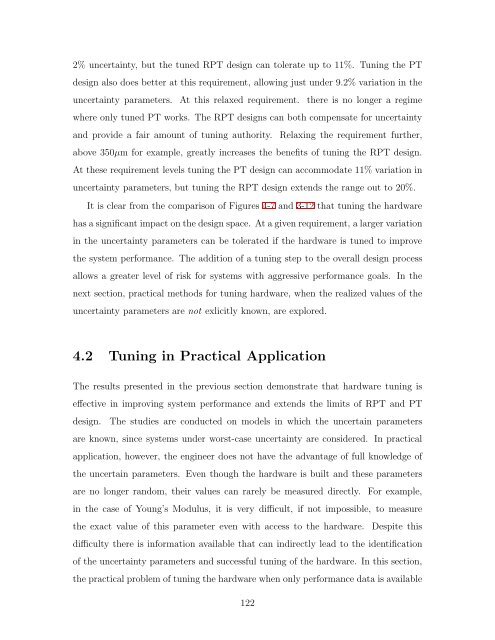Chapter 5 Robust Performance Tailoring with Tuning - SSL - MIT
Chapter 5 Robust Performance Tailoring with Tuning - SSL - MIT
Chapter 5 Robust Performance Tailoring with Tuning - SSL - MIT
You also want an ePaper? Increase the reach of your titles
YUMPU automatically turns print PDFs into web optimized ePapers that Google loves.
2% uncertainty, but the tuned RPT design can tolerate up to 11%. <strong>Tuning</strong> the PT<br />
design also does better at this requirement, allowing just under 9.2% variation in the<br />
uncertainty parameters. At this relaxed requirement. there is no longer a regime<br />
where only tuned PT works. The RPT designs can both compensate for uncertainty<br />
and provide a fair amount of tuning authority. Relaxing the requirement further,<br />
above 350µm for example, greatly increases the benefits of tuning the RPT design.<br />
At these requirement levels tuning the PT design can accommodate 11% variation in<br />
uncertainty parameters, but tuning the RPT design extends the range out to 20%.<br />
It is clear from the comparison of Figures 4-7 and 3-12 that tuning the hardware<br />
has a significant impact on the design space. At a given requirement, a larger variation<br />
in the uncertainty parameters can be tolerated if the hardware is tuned to improve<br />
the system performance. The addition of a tuning step to the overall design process<br />
allows a greater level of risk for systems <strong>with</strong> aggressive performance goals. In the<br />
next section, practical methods for tuning hardware, when the realized values of the<br />
uncertainty parameters are not exlicitly known, are explored.<br />
4.2 <strong>Tuning</strong> in Practical Application<br />
The results presented in the previous section demonstrate that hardware tuning is<br />
effective in improving system performance and extends the limits of RPT and PT<br />
design. The studies are conducted on models in which the uncertain parameters<br />
are known, since systems under worst-case uncertainty are considered. In practical<br />
application, however, the engineer does not have the advantage of full knowledge of<br />
the uncertain parameters. Even though the hardware is built and these parameters<br />
are no longer random, their values can rarely be measured directly. For example,<br />
in the case of Young’s Modulus, it is very difficult, if not impossible, to measure<br />
the exact value of this parameter even <strong>with</strong> access to the hardware. Despite this<br />
difficulty there is information available that can indirectly lead to the identification<br />
of the uncertainty parameters and successful tuning of the hardware. In this section,<br />
the practical problem of tuning the hardware when only performance data is available<br />
122







